Sitmar Line - MS Fairsea 1949 to 1969
Please Note: Firefox and some other search engines are not suitable – Use “Internet Explorer”
for this page to load perfectly!

Click
the logo above to reach the ssMaritime FrontPage for News Updates &
“Ship of the Month”
With Reuben Goossens
Maritime
Historian, Cruise‘n’Ship Reviewer & Author
Please Note: All ssMaritime and other related maritime/cruise sites
are 100% non-commercial and privately owned. Be assured that I am NOT
associated with any shipping or cruise companies or any travel/cruise agencies or
any other organisations! Although the author has been in the passenger shipping
industry since 1960, although is now retired but having completed around 690 Classic Liners and Cargo-Passengers Ships features I trust these will
continue to provide classic ship enthusiasts the information the are
seeking, but above all a great deal of pleasure! Reuben Goossens.
The
Sitmar Ships
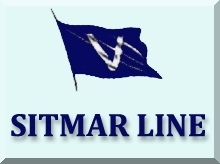
Part Three
MS
Fairsea
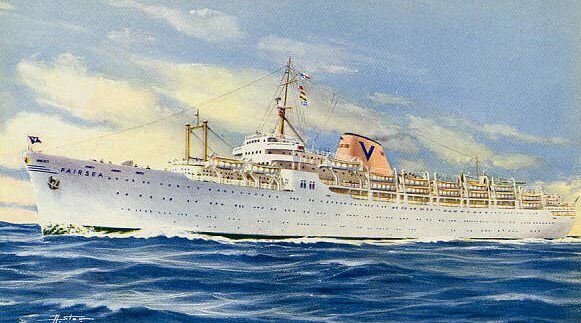
Sitmar
issued this postcard in the mid sixties
Introduction
Introduction
to “The Sitmar Ships”:
Over the years I
have received unbelievable numbers of requests to add a feature on all the
Sitmar Liners and Cruise Ships. Well, it has taken a considerable time, but in
this work, I will present a short history on each ship, together with a number
of photographs. Therefore, I hope and pray that the following pages will have
you reliving your Sitmar experience or possibly experiences, be it sailing to
or from Europe/UK to New
Zealand or Australia
or the America’s
on a line voyage or later as a passenger on one of their many cruises!
I certainly have enjoyed writing and compiling
this very special feature on a company that I greatly love and have sailed with
many times!
Thus now go and read all about … The Sitmar Ships.
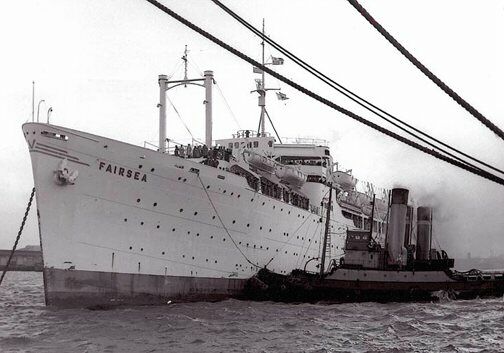
A
fine view of Fairsea in Fremantle (Perth)
Australia
Fairsea
was another converted C3 class ship, originally named Rio de la Plato, a
passenger freighter, ordered by Moore-McCormack Lines. She was built by Sun
Shipbuilding & Drydock Co, Chester
USA
and launched on March
1, 1941. She and her three sisters were the first large diesel
driven ships built in the USA.
Built as a passenger cargo ship, she has accommodations for seventy passengers
and was to sail between New York
and South America.
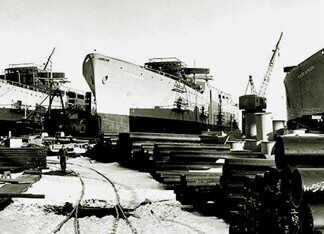
Rio de la
Plata under construction
However,
prior to completion she was taken over by the US Government in October and was
fitted out as an escort carrier for the US Navy. She was handed over to the
Royal Navy, named HMS Charger and was commissioned on March 3, 1942. She served
on convoy duties in the north Atlantic
and had a number of close calls, yet she survived. Later she was returned to
the Americans and placed into service in the Pacific, serving the US Navy with
distinction.
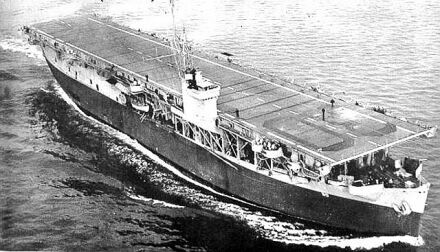
HMS
Charger
Charger
was released from naval service on March 15, 1946, and returned to
Moore-McCormack, who proceeded to remove her flight deck and converted her to
carry troops. This service was brief and she was soon mothballed together with
other ships of her class in the James
River. Like her many sisters, she was placed on the
market.
In 1949, she was
purchased by Alexander
Vlasov, founder of Sitmar Lines placed her under the management of
the Alvion Steam Ship Company. Named the Fairsea she headed for Genoa
where she was reconstructed as an austere emigrant ship with accommodations for
a massive 1,800 persons.
The Fairsea was placed under contract by the
IRO - "International Refugee Organisation" and she would operate
three IRO voyages from Naples
to Melbourne
via the Suez Canal
commencing on May 11, 1949. Under this agreement she would carry Refugees and
displaced persons to Australia,
but she had to return to Italy
without any passengers on board whatsoever. It was for this reason she was not
officially a “Sitmar liner” in the true sense of the word, for that
would not happen until December.
On May 11 Fairsea departed with 1,896 persons
onboard, including 457 children who had come out of various camps from around Europe.
She sailed through the Suez Canal on May 18 and after a brief call at Fremantle
she first arrived at Melbourne
on June 8 and was berthed at Prince’s Pier. Having returned to Naples
empty, she departed again on July 21 with 1,896 persons onboard. Although some
eight countries were represented, there were at least 660 Polish refugees as
well as many from East
Germany. Fairsea
made her call to Fremantle, but continued on to Newcastle
to offload her passenger there at Lee
Wharf
on August 19, 1949. Her third voyage from Naples
with 1,890 passengers onboard was on September 23 arriving in Melbourne
on October 19.
MS Fairsea, now under the control of Sitmar
and Captain Stagnaro, departed from Genoa
to Australia
on December 3 and she arrived in Sydney
on December 31, and berthed at berth 13 Pyrmont. Finally she was able to take
on passengers for the return journey to Italy
and become the Sitmar Liner she was intended to be! Upon her return to Europe
her schedules were changed and she operated the Bremerhaven
to Sydney
service.
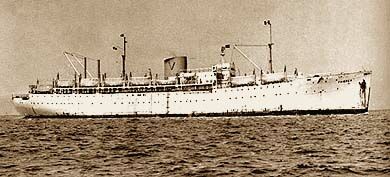
Fairsea
seen during her official maiden voyage as a “passenger liner” on 31
December 1949
A good numbers of C3 Class ships
were converted into migrant ships, including Fairsea’s
Moore-McCormack sister, Mormacmail, which became the German registered
(operated by Holland America Line) Seven Seas. She operated to Canada,
the US,
Australia
as well in New
Zealand, as
well as an occasional cruise ship. Others became the Cogedar Flaminia, and Flotta Lauro Roma and Sydney, also employed on
the Australia
- New
Zealand
service.
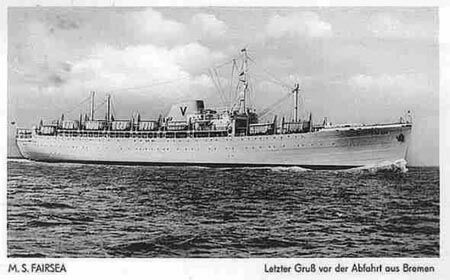
This
postcard was released in January 1954
In
November 1953, whilst berthing in Melbourne,
a fire broke out I the engine room, which was
thankfully quickly extinguished, however with the hosing that took place the
result was that her engine room was flooded. Thus having to do a rapid clean up
and ensuring that all was A-OK, she was able to continue her voyage.
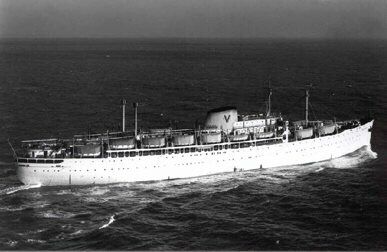
The
MS Fairsea is in seen 1954 after she received a shapely new funnel and a tripod
mast on her bridge.
Note
the derricks aft, these would be removed at the next refit
In December 1953 she
received some cosmetic changes such as her funnel and mast. Having regularly
visited Australia, it was only in February 1957 that she returned home eastward
for the first time, making her Maiden call to New Zealand continuing across the
Pacific, then undertook her first ever transit of the Panama Canal.
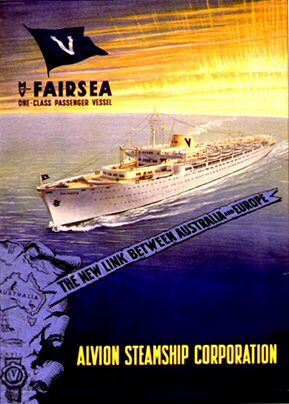
Postcard
of a modernised Fairsea
Click on the post card
above for a delightful informative video of a voyage fro Europe to Canada
With many views of the
ships interiors as well as her exteriors! Or click the link below!
www.ssmaritime.com/MS-Fairsea-1953.flv
In 1958 Fairsea received another refit at Trieste.
Her superstructure was raised one deck, with extensions forward and aft of promenade
deck adding new public rooms. Her aft derricks were removed with one of the
holds became a swimming pool. Air-conditioning was installed and cabins
upgraded. She emerged as a pleasing liner with her tonnage increased 13,432 GRT,
accommodating 1,460 passengers. Interior d?cor was pleasing, exuding Italian
flair. Upon completion she headed Downunder flying the official Sitmar flag for
the first time.
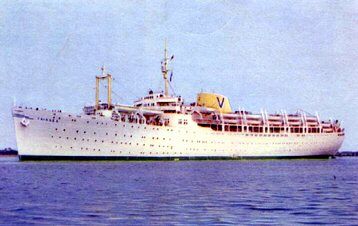
Above & Below: After her 1958 refit,
although still very much a C3 class ship, but her lines were more pleasing
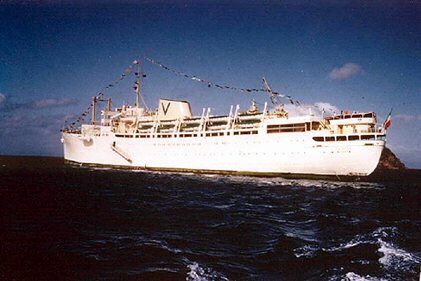
Being
under Government contract, Fairsea continued to transport British passengers to Australia
and News Zealand. In 1961 she received another refit, which saw her
accommodations further upgraded, which saw her capacity reduced to 1,212.
Having become a popular ship in Australia,
Sitmar decided to try her out as a cruise ship. She departed Sydney on July
7, 1966, visiting Cairns,
the Great Barrier Reef (Hayman
Island)
and Melbourne.
In between her line voyages, she continued to undertake the occasional cruise.
Specifications:
Built
by:???????????????????????????? Sun Shipbuilding & Dry Dock Co, Chester
USA.
Yard Nr:????????????????????????????? 188.
Tonnage:??????????????????????????? 11,678 GRT
as built.
???????????????????????????????????????? 13,432 GRT as
Fairsea after 1958 refit.
Length:?????????????????????????????? 492ft / 150m.
Width:??????????????????????????????? 69.2ft
/ 21.1m.
Draught:???????????????????????????? 24.ft.
Engines:???????????????????????????? Doxford Geared
Diesels by the builder - 9,000 BHP.
Screws:????????????????????????????? Single.
Service
speed:???????????????????? 16 knots
– 17 max.
Passengers:???????????????????????? 1,800 One class.
???????????????????????????????????????? 40
First & 1400 Tourist for 6 voyages only in 1953 to Canada.
???????????????????????????????????????? 1,460 after 1958 refit.
???????????????????????????????????????? 1,212 after 1961 refit.
???????????????????????????????????????? Fully air-conditioned.
Former names:??????????????????? Rio De La Plata
1941, Charger 1942-1949.
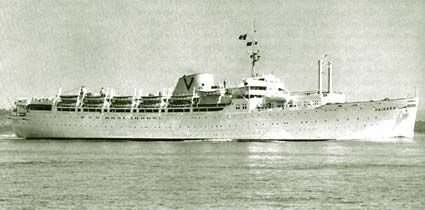
Seen in Wellington
New
Zealand - 1967
On January
14, 1969, Fairsea departed Sydney
with a complement of 986 passengers heading for Southampton.
On the 23rd located around 900 miles west of the Panama
Canal she suffered a fire in the engine room. The ship
and most of her vital facilities, such as the galley, air-conditioning,
toilets, water distilling equipment were all disabled.
Fairsea was towed to Balboa by American ship SS Louise Lykes. Sadly,
the strain was so great, Captain, Ciro Cardia committed suicide whilst in his cabin. Upon arrival
in Balboa, her passengers disembarked and were flown to their destinations. Due
to her having Doxford Diesels, parts were no longer available, thus, it was
decided to dispose of the once popular ship and she was sold to Italian
breakers. On July
9, 1969, she departed under tow of the tug Vortice to La
Spezia Italy,
where she arrived on August 6, to be broken up.
Fairsea Fire – The Bradford Story
Please Note: The story received from Peter and Penney Bradford was in basic
detail and thus I have decided to edit it to a degree to make the story flow
and also clarification, etc. However, all the details are as told by Peter and
Penney!
Peter and Penny Bradford and their two small
children boarded the SS Fairsea in Brisbane
in January 1969 bound for Southampton sailing via Panama
Canal. The voyage started out as normal with the usual
onboard festivities and meals, and of course, not to forget the lifeboat drill.
“As usual we
all had to put on our life jacket's which was a perfect time for a photograph
and I took one of my wife Penney and my three year old son Peter.”
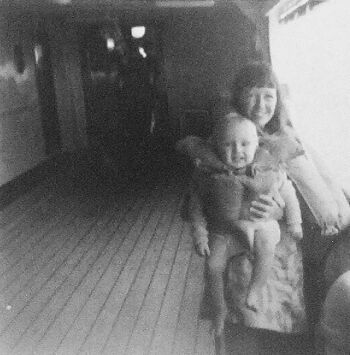
Eleven month old Peter and Penny
out on deck wearing our lifejackets
Photograph ? Peter Bradford
Peter told me that although the Fairsea was
scheduled to make a call at Auckland,
for some reason this port was missed and he wrote …
“Instead we headed straight for Tahiti.
It was not long after we left Tahiti (on January 23) the engine room caught
fire, and when we came up on deck to see what was happening we could see
smoke belching from up from the funnel. Soon the order was given to
abandon ship and lifeboats were prepared at the side of the ship and all
passengers were ordered to put on their lifejackets. However, after hours
of waiting out on deck, we were eventually told that the fire had been
contained and we thankfully did not have to abandon ship after all. You
can imagine that we were very relieved, but were not quite prepared for the
difficulties that ware yet to come.
We noted that the ship was listing
substantially and then when going down to our cabins we discovered that we
could not use our cabins to sleep for the air-conditioning no longer worked as
it was like an oven down there! Thus, it was find a place up above and try and
make yourself as comfortable as possible. After a number of days of
reasonable hardship, considering the crowd onboard, a sea-going tug reached our
ship and they proceeded to pump the diesel oil from the ship to the tug, but
they then discovered that the fuel was unsuitable for the tug and now we had
another situation, for suddenly the tug itself was left helpless and drifting. Fortunately
the sea remained calm, thus it made things a little easier for us
all. However on the 29th, six days after the fire, an
American freighter named the SS Louis Lykes, which
was on its way home from Vietnam,
arrived on the scene.
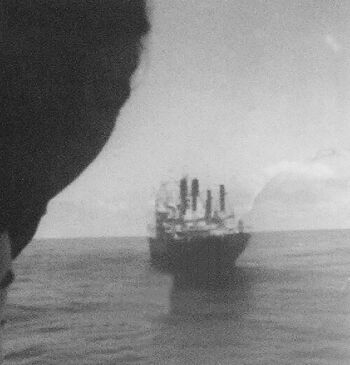
SS Louis Lykes
seen from the starboard side of the Fairsea
Photograph ? Peter Bradford
As soon as the salvage arrangements had been
arranged, SS Louis Lykes took both the Fairsea and
the tug in tow. The tug being towed behind the Fairsea.
We were towed to Panama.
In Panama
we were given the option to either fly to the UK
or wait for another ship. When we returned home to the UK,
our three year old daughter Pauline was rushed to the hospital as she had
caught an unknown virus, which needed urgent attention. She did recover from
her illness although it took some time.
The story had already circulated whilst
we were still on the Fairsea that our Captain had committed suicide, however,
we were never quite sure if the story was factual. But later we realised that
sadly it was true and what a tragedy is was. It was an experience and indeed a
tragedy that we will never forget!”
Peter and Penney have other happy memories
with Sitmar though, for Peter originally came to Australia
in January 1965 on the Fairsea. Then in October 1965 Peter and Penny met whilst
sailing on the TSS Fairstar.
Penney was travelling to England
on a working holiday, and Peter was returning to the UK. The
Fairstar had recently been refitted and Penney remembers that “She was
just a beautiful ship, and thus, beside the sad events of the Fairsea voyage,
we both have very happy memories of Sitmar Line.”
I hereby wish to thank Peter and Penney
Bradford for providing your story of that fateful voyage on the SS Fairsea, a
simple, but a much loved ship by so many!
If you where on that fateful Fairsea voyage or
you wish to communicate with Peter and Penney, you can do so per email: peterpen46@bigpond.com.
******************************
The name Fairsea lived on, as it
was transferred to another Sitmar ship, ex Cunard Liner RMS Carinthia, which received
a massive rebuild in Trieste,
under the name TSS Fairland,
but she departed on her maiden voyage with the name of Fairsea (II) proudly
pained on her bow and stern. Later she became the P&O Princess Cruises TSS
Fair Princess, a successful US and Australian cruise ship. In 2000 she was sold
to become a failed and much troubled (business wise) casino cruise ship, the TSS
China Sea Discovery. However, she was eventually laid up and in August 2005 she
was sold for 4.2 million to Indian breakers and just prior to her departure for India her
name was shortened to “China Discovery”, and she arrived
at Alang on November 20, 2005 and was duly broken up.
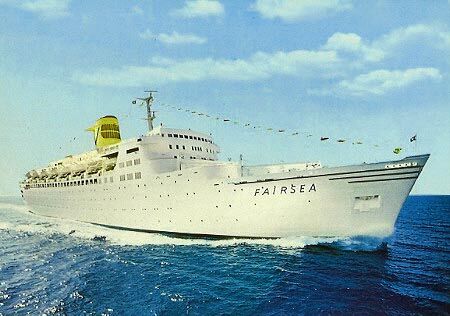
Sitmar’s
new Fairsea, built as the Cunard’s Carinthia.
The Fairsea (I) - INDEX:
Fairsea (1)????? Built as a C3 class freighter History Page - this Page.
Fairsea?????????? Photo Page.
Fairsea?????????? Menus page sent in by John Scholten.
Fairsea ????????? Deck Plan.
Fairsea
????????? The Strachan family migrates from the UK
to Melbourne
in December 1957.
Fairsea?????????? Bob Family
also sails to Melbourne
Barker & in December 1957.
Fairsea?????????? Rob
Barker & Family also sails to Melbourne
in December 1957.
Or
Return to: The Sitmar Ships - INDEX
- For all the Other Sitmar Ships!
“Blue
Water Liners sailing to the distant shores.
I watched them come, I watched them go and I watched them die.”
****************************
Replcia Rolex Day-Date Watches zenith replica Rolex Replica Watches Audemars Piguet Royal Oak Replica
Return
to the ssMaritime Main INDEX
Where
you will discover around 690 Classic Passenger & Passenger-Cargo Liners!
ssMaritime.com & ssMaritime.net
Where
the ships of the past make history & the 1914 built MV Doulos Story
Please
Note: ssmaritime and associated
sites are 100% non-commercial and the author seeks no
funding or favours of any shape or form, never have and never will!
Photographs on ssmaritime and associate pages are by the
author or from the author’s private collection. In addition there are
some images that have been provided by Shipping Companies and private
photographers or collectors. Credit is given to all contributors. However,
there are some photographs provided to me without details regarding the
photographer/owner concerned. I hereby invite if owners of these images would
be so kind to make them-selves known to me (my email address may be found on www.ssmaritime.com only), in order that due credit may be
given.
This
notice covers all pages, although,
and I have done my best to ensure that all photographs are duly credited and
that this notice is displaced on each page, that is, when a page is updated!
ssMaritime
is owned & ? Copyright by Reuben
Goossens - All Rights Reserved















